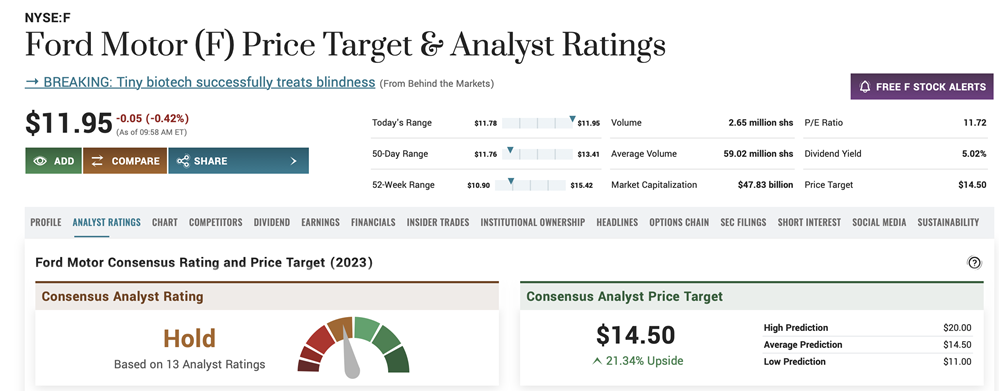
Auto Worker Strike Dents Ford…Buying Opportunity
Just as U.S. auto manufacturers appeared well on the road to recovery, worker unrest is pumping the brakes. As Ford’s negotiations with the United Auto Workers (UAW) enter a third month, headlines around a possible prolonged stalemate continue to pressure shares of the nation’s top automaker. Ford finished in the red for a fifth straight day on Thursday before Friday’s market rally stopped the bleeding. The stock still sits more than 20% below its July 2023 peak.
Early last week, the company sweetened its previous offer to the UAW in an attempt to lock in a new master labor agreement through 2028. The seventh offer since August 29th, it provides for record compensation packages for some 57,000 UAW-backed Ford employees. If approved, the deal would put Ford workers in the top quartile of all U.S. jobs, according to the company.
Unfortunately, it doesn’t appear that the seventh time will be the charm. While the UAW has yet to accept or reject the offer, skepticism continues to mount. The two sides, however, may be getting close to an agreement given Ford’s generous pay and benefit terms and UAW’s seemingly limited leverage at this point.
Until the final handshake is made, though, the issue will continue to be an overhang on Ford’s share price — offsetting solid underlying momentum in the business.
Strong Results Take a Back Seat
A day after making its latest UAW offer, Ford announced that third-quarter vehicles sold grew 7.7%, led by record sales of hybrid and electric vehicles (EVs). Demand for F-Series and Maverick vehicles drove a 41% surge in hybrid sales, while Mustangs Mach-E’s and E-Transit commercial vans led 15% EV sales growth. The results highlight Ford’s domestic market dominance and rising presence in the hybrid/EV segment.
In the second quarter of 2023, Ford’s Model e unit sold more than 34,000 vehicles, a 44% year-over-year increase. While this is a fraction of the 446,000 units Tesla delivered in Q2, it is still respectable growth. It shows that U.S. consumers are embracing a broader set of EV choices beyond Tesla. And in an economy riddled by inflation and rising rates, Ford’s competitive pricing and connected EV technologies are proving to be worth taking for a spin.
In Q3, less than 5% of vehicles sold by Ford were EVs. This can be viewed in one of two ways: 1) the company is getting lapped by Tesla and other EV pure plays (and it’ll take many miles to catch up), or 2) Ford has a long runway for EV growth and could therefore be the more opportunistic EV investment. Considering the multi-year growth trajectory associated with global EV adoption, it makes more sense to opt for the second angle. The reality is that there will be many long-term EV winners — car makers and otherwise — and Ford is in the driver’s seat to be one of them.
In the meantime, the company continues to derive growth from traditional gas-powered vehicles and a brand reputation that’s now 120 years in the making. Through the first six months of 2023, Ford was the best-selling vehicle brand in America. While the new Ford Escape performed well, it’s all about trucks and vans. In Q2, Ford truck sales accelerated 34%, outpacing General Motors. F-Series, the country's top truck, expanded its lead over the Chevy Silverado. Ford Transit sales were up 30% as the commercial van solidified its number-one U.S. ranking.
Along with higher hybrid and EV sales, second-quarter sales grew 12%, marking the fifth consecutive quarter of double-digit growth — and positive top-line surprises. Earnings per share (EPS) were up a more modest 6% but easily topped consensus.

Flashy New EV Lineup
Eventually, the stock market will turn its attention back towards Ford’s growth prospects. This means all eyes will be back on the company’s EV ambitions. As the nation’s transition from internal combustion engines to electric-powered engines unfolds, Ford will be along for the ride. Management forecasts that 40% to 50% of production will be fully electric by 2030.
Leading the charge is the Mustang Mach-E, the automaker’s first EV. This summer, the seventh-generation sporty crossover made its debut in five models ranging from $45,000 to $67,000. Last week, Ford reported that sales surged 90% in the car’s first full month on the market. Consumer interest in sleek new takes on an American classic doesn’t appear to be slowing.
This is good news ahead of next year’s launch of the Mustang Mach-E Rally. Ford unveiled the rugged all-electric vehicle at the IAA Mobility event in Munich, Germany last month. The new Mustang iteration is sure to excite outdoor, recreational vehicle enthusiasts on account of Ford’s first-ever off-road driving mode that enables “bigger slides” and “more aggressive damping” to handle tough turns.
But for Ford’s long-term EV drive to be successful, it will need to replicate its truck dominance in the EV category. That push starts with the F-150 Lightning. Sales of the all-electric pickup fell 46% in the third quarter. This is primarily because the company shut down its Dearborn, Michigan factory for six weeks to expand its annual production capacity to 150,000 trucks.
Ford has also delayed F-150 Lightning deliveries due to “quality checks.” Lightning’s recent numbers have been far from electric, but given the popularity of F-Series trucks, the Dearborn expansion will likely be well-utilized.
The biggest buzz around Ford’s increasingly flashy lineup, though is around “Project Trust the Truck.” Slated to roll off the assembly line in 2025, the next-gen electric pickup is not just the successor to Lightning but also the start of an expanded lineup of Ford electric trucks.
Management has confirmed that Project T3 will involve multiple electrified vehicles — possibly including a smaller, less expensive Ranger-sized pickup. It remains to be seen if expanding the F-Series family leads to stronger sales (or just more diluted sales), but if the strategy gains traction, 2025 financials could be turbocharged.
Earnings, Hedge Fund Ownership Rev Higher
Ford’s EPS have increased sequentially in each of the last three quarters. The $0.72 figure posted in Q2 of this year was the company’s best bottom-line result since the first quarter of 2021.
One group of investors that has taken notice of the accelerating profits is hedge funds. In Q2, hedge fund managers added a net 4.1 million Ford shares to their portfolios. Interestingly, this marked the third straight quarter of hedge fund accumulation. It shows that fundamentals and especially improving earnings, matter much to influential institutions.
Of course, these trades occurred prior to the UAW strike fiasco. When the third quarter 13F filings are submitted to the SEC, it’ll be telling to see how hedgies responded to the events. Did they bail or ride it out?

Shares Get More Af-‘Ford’-able
Retail investors are left to decide if the near-term risks outweigh the long-term growth story. When a deal with the UAW is finally reached, it will undoubtedly come with higher labor costs that are sure to slow Ford’s profit outlook.
As such, analyst sentiment around the stock grew more bearish last week. On October 2nd, Goldman Sachs stuck with a Neutral rating but lowered its price target to $12.00. Wells Fargo reiterated its Sell rating with an $11.00 target.
The good news? This implies a limited downside to Ford’s share price. Since the auto worker strikes began, Wall Street’s revised targets have ranged from $11.oo to $16.00. In other words, the stock could have roughly $4.00 upside and $1.00 downside over the next 12 months. That’s a ratio most investors will take any day.
Meanwhile, Ford’s forward dividend yield has crept back above 5%. This is second only to Stellantis among publicly traded automakers — and more than four times the yield on General Motor shares.
Ford is also starting to scream value from a price-to-earnings (P/E) ratio perspective. It is trading at less than 6x this year’s earnings estimate. Tesla currently goes for 77x. Granted, Ford’s growth metrics are inferior, and its earnings estimates are subject to downward revisions pending the outcome of the labor deal. Nevertheless, the stock is significantly more affordable than it was just a few months ago.
Bottom Line
The uncertainty associated with the UAW standoff has ramped up Ford’s risk profile and hurt the stock. Beneath the surface, though, are improving fundamentals tied to the company’s strength in trucks and emerging position in EVs. Blue chip value investors taking a chance am














